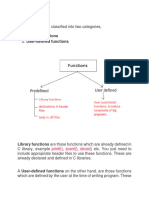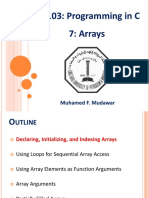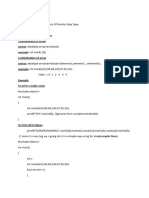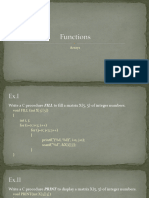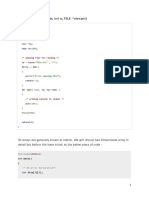0 ratings0% found this document useful (0 votes)
9 views6 pagesC Programming
User-defined functions are custom functions created to perform specific tasks, improving code maintainability and reusability. They consist of three parts: declaration, definition, and call, with various types including recursive functions and functions that accept arrays as parameters. Structures and arrays of structures are also discussed, highlighting their differences and applications in programming.
Uploaded by
nhjamal1234Copyright
© © All Rights Reserved
We take content rights seriously. If you suspect this is your content, claim it here.
Available Formats
Download as PDF or read online on Scribd
0 ratings0% found this document useful (0 votes)
9 views6 pagesC Programming
User-defined functions are custom functions created to perform specific tasks, improving code maintainability and reusability. They consist of three parts: declaration, definition, and call, with various types including recursive functions and functions that accept arrays as parameters. Structures and arrays of structures are also discussed, highlighting their differences and applications in programming.
Uploaded by
nhjamal1234Copyright
© © All Rights Reserved
We take content rights seriously. If you suspect this is your content, claim it here.
Available Formats
Download as PDF or read online on Scribd
You are on page 1/ 6
USER-DEFINED FUNCTIONS Functions that we define ourselves to do certa specific task are referred as user- defined functions. Advani Sf fined fun © The program will be easier to understand, maintain and debug. ‘© Reusable codes that can be used in other programs © Alarge program can be divided into smaller modules. Hence, a large project can be divided among many programmers. Three parts ofa user defined functions are: Function Declaration A function prototype is simply the declaration of a function that specifies function's name, parameters and return type. It doesn't contain function body. A function prototype gives information to the compiler that the function may later be used in the program. Syntax Eunction Definition A function definition in C programming consists of a function header and a function body. Function header consist of return type function name,arguments(parameters) + Return Type: A function may return a value. The return_type is the data type of the value the function returns. Some functions perform the desired operations without returning a value. In this case, the return_type is the keyword void + Function Name: The actual name of the function. The function name and the parameter list together constitute the function signature. + Parameters: A parameter is like a placeholder. When a function is invoked, you pass a value to the parameter. Parameters are optional; that is, a function may contain no parameters. * Function Body: The function body contains a collection of statements that define what the function does. syntax: return type function name( argument list ) ( body of the function Function Call When a program calls a function, the program control i transferred to the called function. A called function performs a defined task and when its return statement is executed or when its function-ending closing brace is reached, it returns the program control back to the main program. Syntax: functionName(parameter list);
‘TYPES OF USER DEFINED FUNCTIONS ees z // function to read two numbers and print its sum void addQ) { int absum; printf("Enter the values of a & b"); scanf("%d%d" &a,&b); sum = a+b; printf("Sum=%d",sum); // function that takes two arguments and print their sum. void add(int a,int b) { int sum; printf("Sum=%d"sum); ) eeu i // function to read two numbers and return its sum intaddQ { int a,b,sum; printf("Enter the values ofa & b"); scanf("%d%d",8a,&b); return sum; // function that takes two arguments and print their sum. int add(int a,int b) { return (a+b); y Function that have multiple return values #include int even(num) { if( num%2==0) return 1; else return 0} } void main { int sa; printf("enter a"); scanf("%d",&a); printf("%d",even(a));
RECURSIVE FUNCTION A function that calls itself is known as a recursive function. And, this techni known as recursion. While using recursion, programmers need to be careful to define a termination condition from the function; otherwise it will go into an infinite loop. ‘Termination condition will be the base case where the problem can be solved without further recursion, Recursion makes program elegant. However, if performance is vital, use loops instead as recursion is usually much slowe: | Write a program to find factorial of a number using recursive function Hinclude int fact(int m) { ifn == 0) return 1; else return n*fact(n-1); } void mainQ { int n; printf("Enter the numbe} scanf("%d",8n); printf("Factorial=%d",fact(n)); y output Enter the number:5 Factorial=120 + Write a program to find nCr and Pr. Hinclude int fact(int n) { if(n else return n*fact(n-1); void main . oureut float GP; rine heer wie naambere Enter the numbers:5 3 scani("%d%d",n,8r); rnCr=10,000000 float) fact(n) / fact(n-r)}; E thoatacatny / (act) = eet(a-r) pis soaoony printiC'nCr=%f\n".C); printi(nPr=%6f"P); } + Write a recursive function to find the sum of first n natural numbers winclude=stdio.h= int sum(int n) { f(n<=0) return 0: else printf("Sum=%d",sum(n)); return n+ sum(n-1); } ourpuT Enter the number:5 Sum=15 void main
PASSING AN ARRAY AS PARAMETER Like the value of simple variables, it is also possible to pass the values of an array to a function. To pass a single dimensional array to a function, it is sufficient to list the name of the array without any subs« Rules to pass an Array to Function pts and the size of the array as arguments. + The function must be called by passing only the name of the array. + In function definition, formal parameter must be an array type; the size of the array does not need to be specified. + The function prototype must show that the argument is an array. ‘+ Write a function to sort an array. #finclude int sort(int Af].int n) € int ij.temp: for(i=0;icn-1ii++) { for(j=0;jen-i-1;j++) c if(AU]>AU+ 1) ( temp = AU: ALi] = AUi+1); Ali+1]= temp: ) , ) ) void mainQ) ‘ int A[30]; inti printf("Enter the limit:"); seanf("%d" 8); for(i=O;ienii++) t printf(“Enter the element:"); seanf("%d".SA(i]); > sort(A.n); printf(*Sorted Array\n’ for(i=Ori int sort(int A[}.int n) ( int ij;temp; for(j=0;jAL+1)) { temp = Ali]: A) = AU+1]: Afje1]= temp; } } ? } void main() int A[30] [30]; y fnter the order of matrix"); Seant("9d%d" m,n): forG=0;iemsi+s) « For(=0;j Onemitt) sore(ali.n’ forU=0:jen:j+) € prinef("96d\e- ATU): > printhe\n"): oureur Enter the element:12 Enter the element Enter the element:25, Enter the element:7 Enter the element:S Enter the element:16 4 oe aietize
Structure Union struct keyword is used to define a structure union keyword is used to define a union Members do not share memory in a structure. Members share the memory space in a ‘Any member can be retrieved at any time ina structure Only one member can be accessed at a time Several members of a structure can be initialized at once. Only the first member can be initialized, Size of the structure is equal to the sum of size of the each member. Size of the union is equal to the size of the largest member. PASSING 2D ARRAY AS PARAMETER Note: While passing 2D array as parameter we need to mention the maxi element of each row that is column. Write a program to pass a 2D mat elements. #include jum size of as parameter and find its sum of all the // function that takes a 2D array and its order int sum(int Af][30],int m,int n) t for(j=0;j struct Student{ char name[30]; int rolinum; int mark for_C; 3 void main({ struct Students[30]; intinsum=0; float avg: printf("Enter the no of Student:"); scanf("%d",&n); for(i=0;i
You might also like
- Department of Computer Science and Engineering Continuous Assesment Test-Iii - Answer Key GE6151-Computer ProgrammingNo ratings yetDepartment of Computer Science and Engineering Continuous Assesment Test-Iii - Answer Key GE6151-Computer Programming11 pages
- CS3353 C Programming and Data Structures 25 PagesNo ratings yetCS3353 C Programming and Data Structures 25 Pages25 pages
- ICS103: Programming in C 7: Arrays: Muhamed F. MudawarNo ratings yetICS103: Programming in C 7: Arrays: Muhamed F. Mudawar41 pages
- Pointers (Part 2), Structures (Part 2), UnionsNo ratings yetPointers (Part 2), Structures (Part 2), Unions37 pages
- C Language-Arrays and Functions: ObjectivesNo ratings yetC Language-Arrays and Functions: Objectives8 pages
- The Printf Function Is Used in Programming (Mainly in LangNo ratings yetThe Printf Function Is Used in Programming (Mainly in Lang71 pages
- Bca11/ Bcs11 - Digital Logic and Programming in CNo ratings yetBca11/ Bcs11 - Digital Logic and Programming in C18 pages







